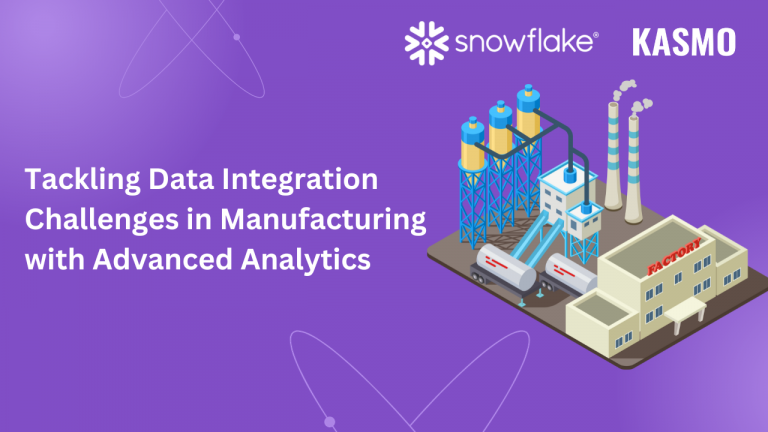The Manufacturing industry is one of the frontrunners in leveraging data to improve operations and continuously innovate processes. Large data volumes from various unstructured and semi structured sources, including IoT sensors and process data, pose data integration challenges. Fragmented data also means that data quality could be compromised, and businesses fail to get a birds-eye view of the true performance, translating to inaccurate planning, prediction, and decision-making. This is where effective data integration strategies play a key role.
What is data integration in manufacturing?
In a nutshell, data integration brings together data from diverse sources into a unified view. This aims to enable seamless flow of information, avoid bottlenecks and ensure data is readily available for analysis. As a manufacturer, an effective data integration strategy can help you integrate data across platforms, making it more meaningful.
According Deloitte’s recent survey, 83% of manufacturers believe that IoT and smart factory solutions will transform the industry in the next 5 years. This only means an explosion of data for manufacturers, and unless the data is stored, processed, and analyzed systematically it could lead to a decision paralysis in the long run. Data integration is imperative for real-time decision making and continuous process improvement.
Common Data Integration Challenges faced by Manufacturers
Fragmented and Outdated Data
The manufacturing industry relies heavily on data to plan for raw materials, allocate labor, and adjust workflows and manufacturing equipment. Data is often generated and stored across different functions including production, quality control, inventory management, and supply chain. This could result in data silos and the inability to capture value from fragmented data sources. Another key drawback faced in integrating multiple industrial data sources is that traditional ERP systems were designed as independent applications and are highly transaction oriented. They were not built to exchange information. Kasmo’s data analytics and AI capabilities help manufacturers to compile their data into one powerful tool.
Roadblocks in manufacturing automation
As the sector is increasingly inclining to smart manufacturing and IIoT, the road to transformation is not an easy for most organizations. Integration of plant floor data sources has troubled manufacturers for decades. The challenge lies in maintaining and integrating data between MES, quality, maintenance, scheduling, IIoT, and other equipment or machine data. Also, the diverse nature of data, variation in formats, granularity, and time periods hinders the data integration process. Manufacturing automation is a data-driven process, and the lack of access to accurate and centralized data could hinder the process of automating tasks.
Data Quality Issues
Discrepancies in data collection protocols can affect the quality of data collected. This is especially true during manual data collection. For instance, two different manufacturing engineers assigned to measure product quality may record the data differently based on their expertise. Also, the data could be prone to errors and duplication. Integrating the inconsistent data collected could prove to be a difficult task. As a result, integrating data stored in multiple sources into the ELT process could be a major roadblock for manufacturers. Furthermore, lack of streamlined data sharing and visibility could also affect the quality of data. A strong data governance strategy establishes processes for data visibility. This ensures that relevant stakeholders have access to the right data at the right time to make informed decisions.
Maintaining Data security
Securing and protecting data against potential cyber-attacks is critical for data integration. As companies increasingly migrate to cloud based data integration, data sets are exposed to potential cyber threats. Clearly laying out protocols to integrate data in legacy systems and cloud will help secure the data integration process. Kasmo facilities data security through the integration process through platforms that offer various data protection options, such as data encryption, data masking, and data retention.
Adopting new technologies
Manufacturing companies often rely on data management methods like cloud computing and data visualization. Any changes on these platforms can affect the quality of data integration. Additionally, if each department in the organization relies on different applications and databases for managing their data, problems arise when there is a need for data integration or cross-departmental data sharing.
Solve Your Data Integration Challenges with Kasmo
The ultimate goal of data integration is to enable centralized data sets that are easily accessible to any end-user in an organization. Unless your data management system is capable of extracting, transforming and loading data from these big data sets to other targeted systems, decision-making could prove to be a challenging task.
Kasmo’s data management solutions are strategically designed to help organizations overcome data integration challenges. It lays out clear policies and procedures to support your data strategy. By partnering with Snowflake, a powerful cloud-based data platform, we help manufacturers unleash the power of AI to generate value from connected technology, enhance supply chain optimization, and prepare for the future of smart manufacturing.
Snowflake’s data cloud for manufacturing
Kasmo leverages manufacturing data cloud to create a foundational cloud platform with data pipelines that can assimilate both IT and OT data at scale. The platform also facilitates IT / OT convergence with a cloud-based precise asset model and plant hierarchy, that is supercharged with Snowflake’s analytics tools – Streamlit and Snowpark. These capabilities are designed to streamline data pipelines and facilitate IT and OT convergence.
Tackle Data Integration challenges with advanced analytics. Connect with our experts to know more.

